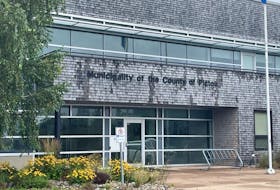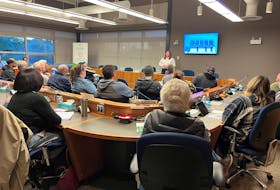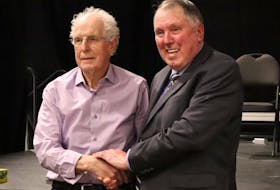SOUTHWESTERN NS - Canada Day got a little shaky in Southwest Nova this year after a small earthquake occurred off of Digby that was also felt in Yarmouth and the surrounding region.
Natural Resources Canada said on July there was a magnitude 3.6 quake 60 kilometres southwest of Digby Neck at 3:32 p.m. July 1. Later, when staff had more time to analysis the data that came in, it adjusted the magnitude of the quake, saying it was a 3.8 quake 42 km northwest from Yarmouth. (Editor's note: the new magnitude was posted on the Natural Resources Canada website on July 2).
There is a survey on the website for anyone who felt the quake.
And lots of people felt it.
In Weymouth, Pamela Thibault said the quake got her attention.
“I thought it might have been a jet flying low so I went outside and there was nothing there,” she said about two hours after the seismic event. “It bothered the dogs though. They were uneasy for a bit and wouldn't settle down.”
In Doucetteville, Digby County, Kendra Amero said her house shook and she thought a forecast storm had moved in early, bringing thunder. She said it felt “like the ground was shaking, and my eight-year-old son turned and looked at me and said ‘did you feel that too?’”
Other members of the Digby Courier Facebook group reported thinking the rumbling was caused by thunder, a truck or a plane overhead – or an explosion.
“Lost two pictures off wall in Meteghan,” Nikki Dorey said. “Whole house shook like crazy. Thought furnace or something was blowing up. Dog was outside and ran back in terrified.”
On Twitter, the quake was noted on Mavilette Beach, but not in downtown Digby.
Tanya Hill, who lives in Glenwood, 20 minutes from Yarmouth, said the quake shook her deck and house. “I ran, grabbed my baby and gathered kids while yelling earthquake, but lucky my kids have had emergency drills before,” Hill wrote on Facebook. “It was scary."
Linda Wakerell who lives near the Yarmouth airport, reported that pictures fell off of her walls. “The roaring sound was what one would envision an avalanche of rocks falling from a mountain,” she said.
Widespread shaking
The earthquake was felt throughout southwest Nova Scotia.
In the Yarmouth Vanguard newspaper building in downtown Yarmouth, there was a loud rumbling sound that was accompanied by vibrations at the same time. The rumbling sound, which sounded like it was coming from above, got increasingly louder until what felt like a loud impact or a violent jolt and then the building shook hard. Newsroom staff wondered whether something had crashed or exploded.
Allison Bent, a seismologist with Earthquakes Canada/Natural Resources Canada said this is the typical type of description for an earthquake this size.
“People will often say it sounded like a heavy truck or a train impacted something, or something hit the building. That’s sounds about right for something that size,” she said.
Bent had said on July 1 the epicenter was 60 kilometres southwest of Digby, which would just put it slightly offshore. A map shows it have occurred off of Brier Island. (Editor's note: On July 2 that epicenter was adjusted to 42 km northwest of Yarmouth.)
“It’s big enough that it would be felt not at really large distances, but probably over a bit of an area, not just one location, but there shouldn’t have been any damage or anything like that.” She said they had gotten lots of reports about the earthquake being felt in Yarmouth, which is an hour's drive from Digby.
Social media reaction
While there may not have been much damage, people immediately felt it and wondered what it was they had just experienced. Immediately people started commenting on social media, asking if the area had just experienced an earthquake.
It might seem like a rare question, except that a magnitude 2.9 earthquake occurred in the Digby region on June 20. That one happened around 38 kilometres southeast of Digby at 11:40 a.m. It hit a remote section of Kejimkujik National Park. Most people weren't even aware it had happened.
And according to Natural Resources Canada there was also a 2.5 magnitude earthquake on June 27. That one was 39 km southeast of Digby. Again, it went largely unnoticed.
That wasn't the case with this July 1 quake, however.
On the Vanguard’s Facebook page people described what it felt and sounded like. Many people said at first they thought it was thunder. But as they absorbed their experience some weren't quite sure what to make of it.
“The items started to rattle and vibrate...then a high pitch vibration I could hear. It was weird. Was not a rumble of thunder, as the dog never barks at thunder. But her ears went up high and she barked,” said Sharon Fitzgerald-Doucette describing things in Arcadia, just outside of the town of Yarmouth.
In Yarmouth County people reported experiencing something in numerous communities, including Dayton, Port Mailtand, South Ohio, Sluice Point, Wedgeport, Kempt, Abrams River, Rockville, Sandford and on and on came the reports.
In the Clare area, people in places like Meteghan, Doucetteville, St, Alphonse and Saint Joseph people reported that their houses shook.
“We felt it here in Weymouth area too, shook the house, dogs went crazy, barking," said Claudette Wright on the Vanguard’s Facebook page.
Nancy Bullerwell LeBlanc said in Plymouth, Yarmouth County, it rattled dishes in her house. In Little River Harbour, Tanya Reed said, “I head a sound like a train going by and my whole house and windows shook and rattled and I felt vibrations.
“We felt it loud and clear in South Ohio, wow,” said Debbie Warren Gavel.
However, some people in the region say they didn't feel anything.
A 2.2 magnitude aftershock 32 km from Yarmouth was recorded about seven minutes after the 3.8 earthquake.
Are earthquakes common for N.S.?
Back at the Earthquakes Canada office, Allison Bent said Nova Scotia doesn’t have quite as many earthquakes as New Brunswick. But, she said, earthquakes this small can happen almost anywhere and it is part of the same geological system as N.B. So it would make sense, she said, that this earthquake was more towards the New Brunswick side of Nova Scotia.
“They’re not common, but they’re not so rare that we’re totally surprised by it,” she said. “Up to about magnitude 4 can happen almost anywhere. Bigger than that, while they can surprise us, they tend to happen in known areas of higher level of activity.”
When you hear of larger earthquakes, you also hear about aftershocks. Asked whether this would happen with an earthquake this size, Bent said, “Aftershocks might not happen with something this size and if they did they would potentially be so small that no one would notice them. But it is possible that you might feel another shake or two in the next couple of days.”
On the Natural Resources Canada website it stated there were no reports of damage from the earthquake “and none would be expected.” Asked if there is a threshold as to when earthquakes will cause noticeable damage, Bent said there’s not “a magic number.”
“It’s a combination of how well built your buildings are, how far away you are. Generally somewhere around magnitude 4.5 to 5 you see light damage. It often tends to be more contents of buildings as opposed to the buildings themselves. Things fall over, maybe windows break," she said. "It’s closer to magnitude 6, generally, before you start to see significant damage. And even that can vary a lot. Places with extremely good building codes might not get much from a magnitude 6 and other areas might.”
Bent said there is a network of about 200 stations scattered throughout the country that measure seismic activity. All of the data is transmitted in real time to the office in Ottawa and then a back-up office just outside of Victoria.
“Computers do a lot of the initial processing, so we can tell very quickly, generally, if there was something,” she said. That information is then verified by staff, she said, adding the information is always verified by staff before confirmation is made as to whether it was indeed an earthquake.
With files from Jennifer Hoegg








